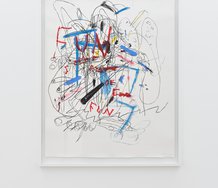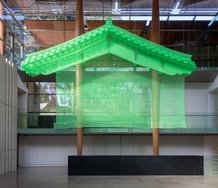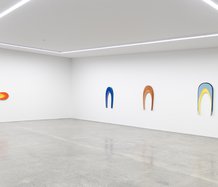John Hurrell – 26 October, 2018
Descriptive textures of corrosion and gravitational collapse are visually everywhere, not with the intention of romanticising, but more of assisting historical and economical analysis. As images to closely scrutinise they are absorbing. You wonder about the back stories for each picture of desolation and decay. What labour—what lives—were embedded in that building on a daily basis when activities were at their peak?
The transience of architecture, especially when such structures have been serving the interests of nineteenth and twentieth century capitalism when extracting minerals out of the land, is the dominant theme of these eight coloured photographs-recently made by Chris Corson-Scott in the South Island.
Mostly of decaying buildings (and on one occasion, 300 beached pilot whales at Farewell Spit), Corson-Scott‘s eco-sensitive images attempt to reference our species’ waste of natural resources, while delighting in natural light, landscape and cloud forms, and allusions to many participants in the history of NZ landscape painting. In the latter, references to Lusk, Angus, Lovell-Smith, Wong and Sydney abound. In most there is a strong sense of nature reasserting itself, and building components left lying where they have fallen, soon to be covered over by vegetation and dirt.
Corson-Scott’s use of consistent detail make irresistible for history lovers his documentation of the various rural sites of woollen mills, lime grinding for fertiliser, goldmining, and freezing works. Descriptive textures of corrosion and gravitational collapse are visually everywhere, not with the intention of romanticising, but more of assisting historical and economical analysis. As images to closely scrutinise they are absorbing. You wonder about the back stories for each picture of desolation and decay. What labour—what lives—were embedded in that building on a daily basis when activities were at their peak?
The other theme that Corson-Scott raises is of course the waste resulting from such longterm extraction of minerals and nutrients from the earth. He also raises the issue of computers and cell phones, and the various rare metals they are exhausting. There is a crisis with digital technology looming up.
The excellent softcover book published with this show has beautiful images of all the works plus some other recent photographs not on the walls: of tobacco drying kilns, a saltworks outlet pipe, and a stamping battery that pounds gold ore rather than grinding it. It includes a very informative conversation between Corson-Scott and Emil McAvoy about how he goes about accessing the sites and making these pictures, accompanied by two insightful essays by Laurence Simmonds and Chris Holdaway. A nice supplement for the show.
John Hurrell
 Advertising in this column
Advertising in this column Two Rooms presents a program of residencies and projects
Two Rooms presents a program of residencies and projects



This Discussion has 0 comments.
Comment
Participate
Register to Participate.
Sign in
Sign in to an existing account.